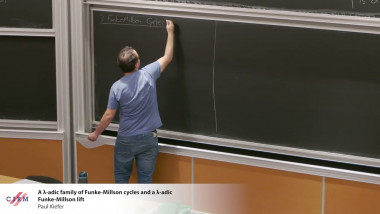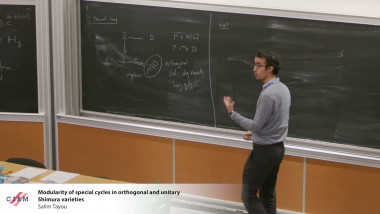
A $\lambda$-adic family of Funke-Millson cycles and a $\lambda$-adic Funke-Millson lift
De Paul Kiefer

Modularity of special cycles in orthogonal and unitary Shimura varieties
De Salim Tayou
Apparaît dans la collection : Jean-Morlet Chair 2020 - Conference: Diophantine Problems, Determinism and Randomness / Chaire Jean-Morlet 2020 - Conférence : Problèmes diophantiens, déterminisme et aléatoire
For an integer n, a set of distinct nonzero integers $\left \{ a_{1},a_{2},...a_{m} \right }$ such that $a_{i}a_{j}+n$ is a perfect square for all 1 ≤ i < j ≤ m, is called a Diophantine m-tuple with the property $D(n)$ or simply a $D(n)$-set. $D(1)$-sets are known as Diophantine m-tuples. When considering $D(n)$-sets, usually an integer n is fixed in advance. However, we may ask if a set can have the property $D(n)$ for several different n’s. For example, {8, 21, 55} is a $D(1)$-triple and $D(4321)$-triple. In a joint work with Adzaga, Kreso and Tadic, we presented several families of Diophantine triples which are $D(n)$-sets for two distinct n’s with $n\neq 1$. In a joint work with Petricevic we proved that there are infinitely many (essentially different) quadruples which are simultaneously $D(n_{1})$-quadruples and $D(n_{2})$-quadruples with $n_{1}\neq n_{2}$. Morever, the elements in some of these quadruples are squares, so they are also $D(0)$-quadruples. E.g. $\left \{ 54^{2}, 100^{2}, 168^{2}, 364^{2}\right } $ is a $D(8190^{2})$, $D(40320^{2})$ and $D(0)$-quadruple. In this talk, we will describe methods used in constructions of mentioned triples and quadruples. We will also mention a work in progress with Kazalicki and Petricevic on $D(n)$-quintuples with square elements (so they are also $D(0)$-quintuples). There are infinitely many such quintuples. One example is a $D(4804802)$-quintuple $\left \{ 225^{2}, 286^{2}, 819^{2}, 1408^{2}, 2548^{2}\right }$.
